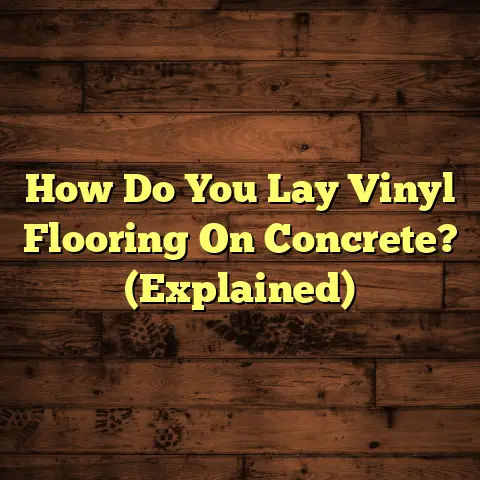Hardwood Flooring Prices In India: (Costly?)
I’ve seen firsthand the growing love for hardwood floors in our homes. There’s just something about that natural warmth and timeless elegance, right?
But let’s be real, the price tag can be a bit of a shocker. Are hardwood floors really that expensive?
That’s what we’re going to dive into today. We’ll break down the costs, explore regional differences, and compare hardwood to other options. By the end, you’ll have a clear picture and can decide if hardwood is the right investment for you.
Think of it this way: are we paying a premium for lasting value, or are there smarter ways to achieve that dream aesthetic? Let’s find out!
Section 1: Understanding Hardwood Flooring
Okay, so what exactly is hardwood flooring? Simply put, it’s any flooring made from a single piece of wood, typically from deciduous trees like oak, maple, or teak.
In India, we often see two main types:
-
Solid Hardwood: This is the real deal – a solid plank of wood. It’s durable, can be refinished multiple times, and adds serious value to your home.
-
Engineered Hardwood: This is made of layers, with a hardwood veneer on top and plywood or fiberboard underneath. It’s more stable than solid hardwood, especially in humid climates, and often a bit more budget-friendly.
Why the Hardwood Hype?
Why are people so drawn to hardwood, despite the price? I think it boils down to these key factors:
-
Longevity: Hardwood floors, when properly maintained, can last for decades, even generations.
-
Aesthetic Versatility: From rustic to modern, hardwood complements any design style. You can stain it, sand it, and customize it to your heart’s content.
-
Property Value: There’s no denying it – hardwood floors are a major selling point. They instantly elevate a home’s appeal and perceived value.
A Quick History Lesson
Hardwood flooring wasn’t always accessible to the average Indian homeowner. Historically, it was a luxury reserved for palaces and grand estates. Think back to the colonial era, when teak and mahogany were prized materials.
Over time, with advancements in manufacturing and sourcing, hardwood became more attainable. Today, you’ll find it in apartments, bungalows, and everything in between.
Section 2: Breakdown of Costs
Alright, let’s get down to the nitty-gritty: the cost breakdown. This is where things can get complex, so bear with me.
The overall cost of hardwood flooring depends on a bunch of factors. Let’s look at them one by one:
-
Type of Wood: This is a big one. Teak, known for its durability and water resistance, is generally more expensive than, say, mango wood. Imported woods like oak and maple also come with a higher price tag.
- Teak: ₹800 – ₹2,500 per sq ft
- Oak: ₹700 – ₹2,000 per sq ft (imported)
- Maple: ₹600 – ₹1,800 per sq ft (imported)
- Mahogany: ₹750 – ₹2,200 per sq ft
- Mango: ₹400 – ₹1,200 per sq ft
Note: These prices are approximate and can vary based on supplier, quality, and region.
-
Quality and Grade: Wood is graded based on its appearance – the number of knots, color variations, and overall consistency. Higher grades (like “clear grade”) are more uniform and therefore more expensive.
-
Sourcing and Availability: Local vs. imported is a huge factor. Imported woods incur additional costs for shipping, customs duties, and handling. Also, some wood species are more readily available in certain regions, which can impact the price.
-
Installation Costs: Don’t forget about labor! Professional installation is crucial for a long-lasting, beautiful floor. Installation costs can range from ₹150 to ₹500 per square foot, depending on the complexity of the job and the installer’s rates. This includes subfloor preparation, which can add to the cost if your existing floor isn’t level or needs repairs.
-
Maintenance and Long-Term Costs: Hardwood needs some TLC. Refinishing, which involves sanding and applying a new coat of finish, is typically needed every 8-12 years. This can cost anywhere from ₹200 to ₹400 per square foot. Regular cleaning and polishing are also essential.
Let’s consider a hypothetical example:
Say you’re flooring a 200 sq ft room with good-quality teak, installed professionally:
- Teak Wood (₹1500/sq ft): ₹300,000
- Installation (₹300/sq ft): ₹60,000
- Total: ₹360,000
That’s a significant investment!
Section 3: Regional Price Variations
Now, let’s zoom in on how prices change across India. You’ll find that hardwood flooring costs aren’t uniform nationwide.
-
Urban vs. Rural: Generally, you’ll find higher prices in major metropolitan areas like Mumbai, Delhi, and Bangalore. This is due to higher overhead costs for businesses, increased demand, and the prevalence of imported materials. Rural areas might offer slightly lower prices, but selection could be limited.
-
Local Demand and Supply: If a particular wood species is readily available in a region (say, teak in Kerala), you might find more competitive pricing. Conversely, if demand is high and supply is low, prices will inevitably rise.
-
Raw Materials and Transportation: Transportation costs play a significant role. Moving heavy wood planks across long distances adds to the overall expense. Regions closer to timber sources (like the Northeast) may have a slight advantage.
Case Studies:
-
Mumbai: High demand, high real estate values, and a preference for imported woods drive up prices. You’ll find a wide range of options, but be prepared to pay a premium.
-
Kerala: Teak is abundant here, so you might find better deals on teak flooring compared to other regions. However, specialized installation services might still be costly.
-
Delhi: A mix of local and imported woods are available. Prices are generally competitive, but be sure to shop around and compare quotes from different suppliers.
Section 4: Comparing Hardwood Flooring with Other Flooring Options
Okay, let’s put hardwood in perspective. How does it stack up against other popular flooring choices in India?
Here’s a quick comparison:
| Flooring Type | Price Range (₹ per sq ft) | Pros | Cons |
|---|---|---|---|
| Hardwood | 400 – 2500 | Durable, beautiful, adds value, can be refinished | Expensive, susceptible to moisture, requires maintenance |
| Laminate | 150 – 400 | Affordable, easy to install, scratch-resistant | Not as durable as hardwood, can’t be refinished, less authentic look |
| Vinyl | 100 – 350 | Waterproof, low maintenance, affordable | Less luxurious feel, can be damaged easily, lower resale value |
| Tiles (Ceramic/Porcelain) | 80 – 600 | Durable, water-resistant, variety of styles | Can be cold, hard underfoot, grout requires cleaning |
Long-Term Investment:
This is where hardwood really shines. While the initial cost is higher, its durability and potential to increase property value make it a worthwhile investment in the long run. Think of it as an asset that appreciates over time.
Laminate and vinyl are cheaper upfront, but they might need to be replaced sooner. Plus, they don’t add the same level of prestige or resale value to your home. Tiles are durable, but they lack the warmth and elegance of wood.
Section 5: Factors Influencing Price Fluctuations
Finally, let’s talk about what can make hardwood prices jump around.
-
Economic Factors: Inflation, currency exchange rates (especially for imported woods), and overall economic growth can all impact prices. A weaker rupee, for example, will make imported woods more expensive.
-
Environmental Concerns: Sustainability is a growing concern. Deforestation and illegal logging practices can disrupt the supply chain and drive up prices for sustainably sourced wood.
-
Government Policies: Regulations related to timber sourcing, trade, and environmental protection can also affect prices. For example, restrictions on logging certain species can limit supply and increase costs.
-
Market Trends: Consumer preferences play a role. If there’s a sudden surge in demand for a particular type of wood, prices will likely increase. Also, new flooring technologies and innovations can impact the market.
Conclusion
So, are hardwood flooring prices in India costly? The answer, as you’ve probably gathered, is… it depends!
It depends on the type of wood, the quality, where you live, and a whole host of other factors.
But here’s what I want you to take away: hardwood flooring is more than just a surface covering. It’s an investment in your home’s beauty, durability, and value.
While the initial cost might seem high, consider the long-term benefits. A well-maintained hardwood floor can last for generations, adding character and charm to your home while potentially increasing its resale value.
Ultimately, the decision is yours. Weigh the costs against the benefits, do your research, and choose the flooring option that best fits your budget, lifestyle, and aesthetic preferences.
And remember, I’m always here to help if you have any questions! Happy flooring!





